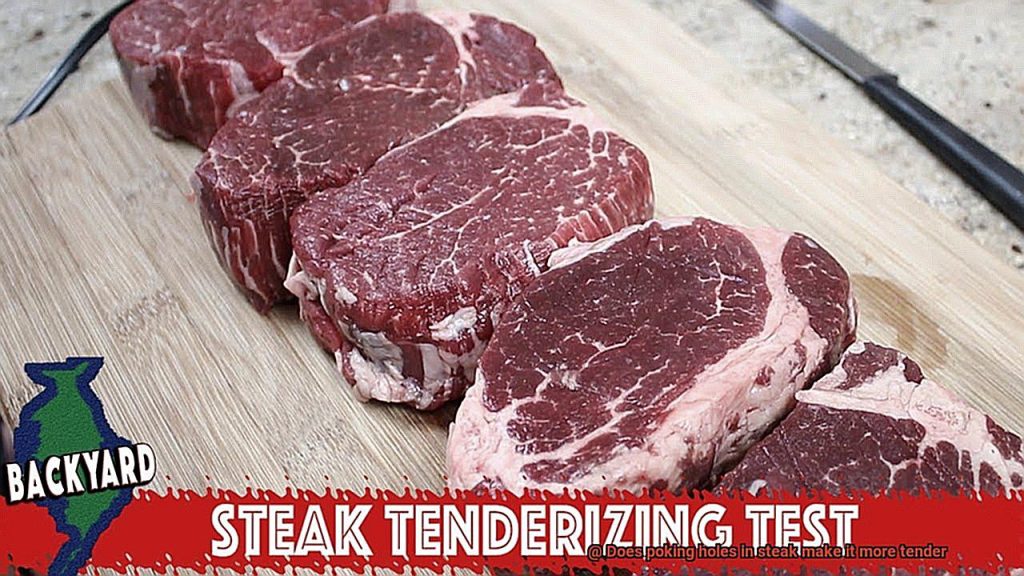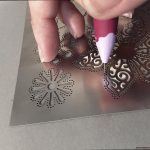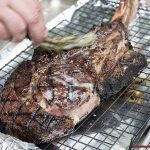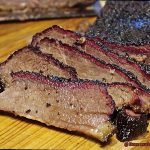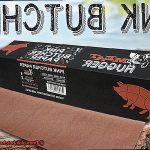Are you a steak lover who’s tired of battling tough meat? If you’ve scoured the internet for ways to soften your steak, you might have stumbled upon the suggestion to poke holes in it before cooking. But does this trick actually work, or is it just a tall tale?
As someone who’s passionate about food and an expert in the field, I’ve been asked countless times: does poking holes in steak make it more tender? Unfortunately, there’s no clear-cut answer – opinions are divided and information can be misleading.
Fortunately, science has stepped in to shed light on what really happens when we pierce our steaks with knives or forks. By conducting meticulous research and experiments, we can finally get to the bottom of whether or not this method is effective.
In this article, we’ll delve into the science behind poking holes in steak, how it affects the meat itself, and whether or not it truly results in a melt-in-your-mouth experience. So if you’re keen to learn more about this culinary technique that could make all the difference to your next meal, read on.
Contents
What is the Theory Behind Poking Holes in Steak?
Muscle fibers in meat can contract during cooking, resulting in a dry and tough texture. The solution? By poking small holes into the meat, chefs aim to break up these fibers, allowing them to relax and become more tender during cooking. This process is known as “jaccarding” or “meat tenderizing.”
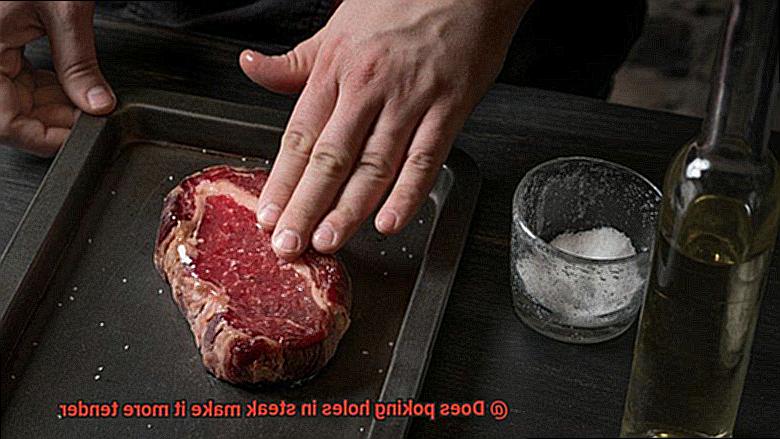
The best part? You don’t need any fancy equipment to try this technique at home. A fork, toothpick, or specialized meat tenderizer with sharp blades will do the trick. Some chefs even add a marinade or seasoning mixture to the meat before jaccarding to enhance flavor absorption.
But does it actually work? While there is some debate among chefs and food scientists about its effectiveness, some studies have shown that jaccarding can lead to slightly more tender meat. Factors such as the type of meat being cooked and how it is prepared may also play a role in its effectiveness.
However, it’s important to be cautious when using this technique. Over-poking the meat can lead to dryness and even tearing. So take it slow and steady, and keep an eye on your meat during cooking.
Arguments Against Poking Holes in Steak
There are several compelling arguments against this technique that should be taken into consideration before resorting to it.
First and foremost, poking holes in steak can lead to a loss of the essential juices that keep the meat moist and flavorful. These juices are vital to creating a succulent, delicious steak, and poking holes can cause them to escape during cooking. This can result in a dry, tough piece of meat that is far from the juicy, melt-in-your-mouth experience you were hoping for.
Furthermore, poking holes in steak can create uneven cooking. The steak may cook unevenly, resulting in an inconsistent texture and flavor that can be unappetizing. If you’re not cautious about cleaning your utensils and surfaces properly before poking the steak, you can increase the risk of bacterial contamination – a serious concern when it comes to food safety.
Another significant drawback is that there is no scientific evidence to support the idea that poking holes in steak actually makes it more tender. While some people swear by this technique, many experts believe that it can have the opposite effect and make the meat tougher. So while there may be some potential benefits to be gained from jaccarding or meat tenderizing, it’s best to approach this technique with caution and only use it sparingly.
Additionally, poking holes in a steak can change its texture. It can break down the meat too much and result in a mushy and unappetizing texture. Moreover, if you poke holes in a steak with bones, you may end up with small bone fragments in your meat.
Lastly, there is always the risk of over-poking the steak, which can cause irreversible damage to the integrity of the meat.
Arguments For Poking Holes in Steak
Consider poking holes in it before cooking. While some may argue against this technique, there are several compelling reasons to give it a try.
Firstly, poking holes in your steak can help the marinade or seasoning penetrate deeper into the meat. This creates a more complex and delicious taste. It also helps to tenderize the meat by breaking down tough fibers and connective tissue. This is particularly useful for tougher cuts of meat.
Additionally, poking holes in your steak can help reduce cooking time. The tiny channels created by the holes allow heat to penetrate the meat more quickly and evenly, resulting in a juicier finished product. This can be especially beneficial when grilling thicker cuts of meat that may take longer to cook through.
Finally, poking holes in your steak can create a unique texture and pattern on its surface, making it visually appealing. This adds interest and intrigue to your dish.
However, it’s essential to exercise caution when using this technique. Over-poking or making the holes too large can cause the meat to dry out or lose its flavor. Additionally, acidic marinades or seasonings must be used carefully, as over-marinating can also lead to a dry and tough finished product.
How to Properly Poke Holes in Steak
Properly poking holes in your steak can help tenderize the meat and enhance its flavor. But, beware. There is a right and wrong way to do it.
The Right Tool for the Job
Using the right tool is crucial for properly poking holes in your steak. A fork is not recommended as it can tear the meat fibers, causing moisture to escape and resulting in a dry and tough steak. Instead, use a meat tenderizer with small needles or blades that can puncture the meat without damaging it.
Timing is Everything
Timing is key when it comes to poking holes in your steak. It’s best to do this before cooking as it allows time for the meat to absorb any marinade or seasoning that may be applied. This also gives the meat time to break down naturally, which can further aid in tenderizing.
Evenly Distributed Holes
Distribute the holes evenly across the entire surface of the steak. Avoid clustering too many holes in one area as this can cause uneven cooking and potentially ruin the texture of the meat.
Avoid Over-poking
Be careful not to over-poke your steak as this can tear the meat and ruin the texture altogether. Aim for poking about 20-30 times on each side of the steak, making sure not to go all the way through the meat.
Be Gentle
When poking your steak, use a gentle touch and let the prongs do the work. Applying too much pressure can damage the fibers of the meat and make it tough.
Benefits of Poking Holes in Steak
The benefits of this technique are numerous, and here are some of them:
Firstly, poking holes in steak creates small pockets that allow marinades to seep deeper into the meat. This results in more flavorful and aromatic steaks that will leave your taste buds craving for more. The increased marination also boosts the juiciness of the steak.
Secondly, poking holes helps to reduce cooking time by making the meat thinner. As a result, heat penetrates it faster and more efficiently, leading to perfectly cooked steaks every time. This is especially helpful for thicker cuts of meat that take longer to cook.
Thirdly, poking holes in steak helps to distribute heat evenly throughout the meat. This means that you won’t end up with an overcooked exterior and an undercooked interior. Instead, your steak will have a well-cooked consistency from edge to edge.
Lastly, poking holes in steak can help improve its texture, making it more tender and succulent. By breaking down some of the fibers in the meat, you can achieve a melt-in-your-mouth texture that will make you savor every bite.
It is important to note that not all cuts of meat require this method of tenderizing. Some cuts are naturally tender and don’t need any additional help. Additionally, over-poking or using too much force when poking can damage the meat and make it tougher.
Drawbacks of Poking Holes in Steak
While this method may seem like a quick fix, it comes with some serious drawbacks that you should be aware of.
Firstly, poking holes in your steak can cause the precious juices to escape from the meat. These juices are what give your steak its flavor and moisture, so losing them can leave you with a dry and unappetizing piece of meat. The small openings created by poking the meat with a fork or knife allow the juices to flow out, resulting in a less flavorful and less enjoyable meal.
In addition to affecting flavor, poking holes in your steak can also increase the risk of bacterial contamination. The punctured surface of the meat allows bacteria from the outside environment to enter and contaminate the interior. This is particularly concerning if you’re not planning to cook your steak to a high enough temperature to kill off any harmful bacteria.
Lastly, poking holes in your steak can lead to uneven cooking. The punctured areas will cook faster than others, resulting in an inconsistent texture and flavor throughout the steak. This can be frustrating when you’re trying to achieve a perfectly cooked meal.
Fortunately, there are alternative methods for achieving a tender and flavorful steak without compromising its quality. Marinating your meat before cooking can infuse it with flavor and break down tough fibers without risking bacterial contamination. Another option is using a meat tenderizer tool that doesn’t puncture the meat but rather breaks up the fibers for a more tender result.
Best Practices for Poking Holes in Steak
If you’re looking for a way to make your steak more tender and delicious, then consider poking some holes in it. But before you start piercing away, it’s important to know the best practices for poking holes in steak.
Firstly, it’s crucial to understand that not all steaks are the same. Tougher cuts like flank or skirt steak can benefit from being poked with a fork or meat tenderizer to break down the tough muscle fibers. However, more tender cuts like ribeye or filet mignon may actually become dry and lose their juices if you poke them.
To properly poke holes in your steak, follow these easy steps:
- Be gentle: Aggressive poking can ruin the texture of your meat. Use a fork or meat tenderizer to puncture small holes evenly across the surface of the meat, avoiding large tears.
- Choose the right tool: A fork works well for smaller cuts, but for larger ones, use a meat tenderizer tool for best results.
- Give it time: Allow your steak to rest for at least 30 minutes after poking. This will give it time to absorb any marinade or seasoning you’ve added.
- Consider marinating: If you’d rather not poke holes in your steak, marinating it in acidic liquids like vinegar or citrus juice can help break down the muscle fibers and make it more tender. However, be careful not to marinate for too long as this can cause the meat to become mushy.
2ua_v4BA3qM” >
Conclusion
In the culinary world, there is a never-ending debate about whether poking holes in steak makes it more tender. While some chefs and food scientists swear by this technique, others argue against it.
The idea behind poking holes in steak is to break up the muscle fibers in the meat, which can make it more tender during cooking. However, there are pros and cons to this method.
On one hand, poking holes in steak can help marinades seep deeper into the meat, shorten cooking time, and improve texture. On the other hand, it can also cause juices to escape from the meat, increase the risk of bacterial contamination, and result in uneven cooking.
To execute this technique properly, you must choose the right tool and be gentle with your approach. It’s also essential to note that not all cuts of meat require poking holes for tenderizing. Some cuts may benefit more from marinating or using a meat tenderizer tool that doesn’t puncture the meat.
Ultimately, whether or not you poke holes in your steak depends on personal preference and several factors such as cut type and cooking method.

